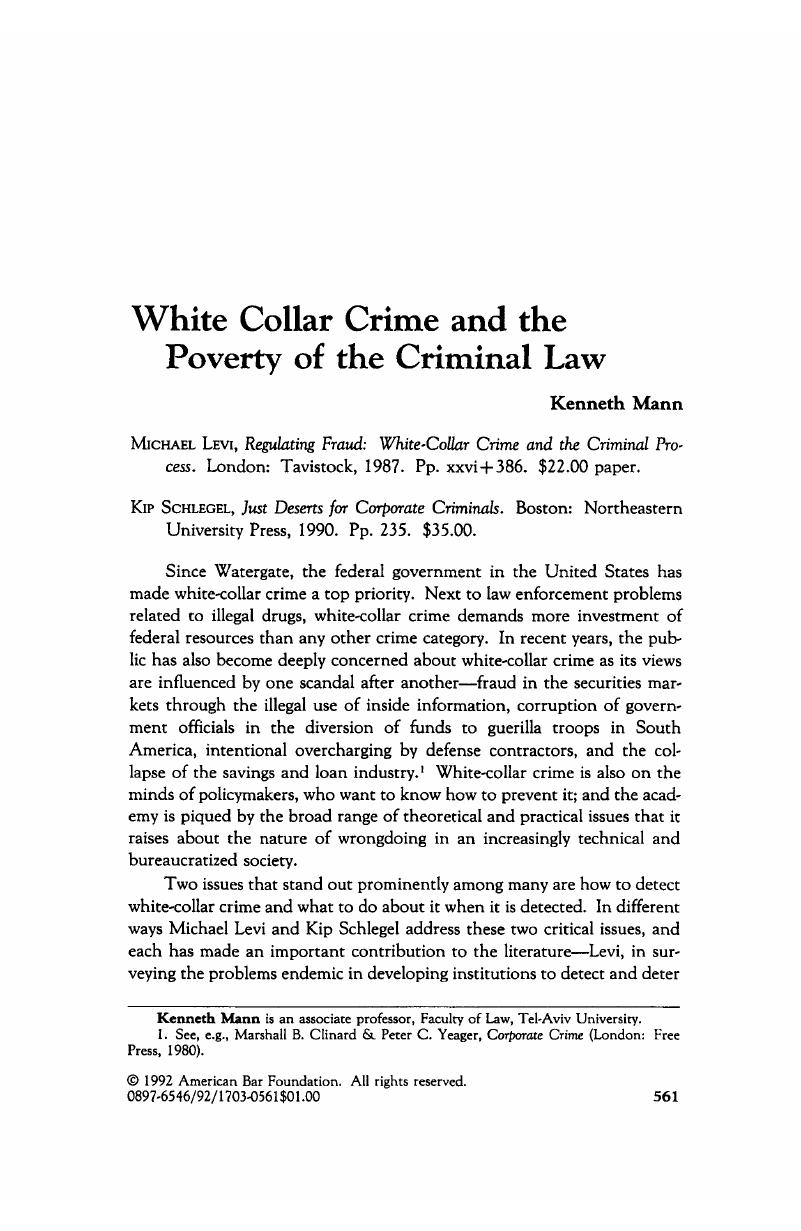Article contents
White Collar Crime and the Poverty of the Criminal Law
Published online by Cambridge University Press: 27 December 2018
Abstract

- Type
- Review Essay
- Information
- Copyright
- Copyright © American Bar Foundation, 1992
References
1 See, e.g., Marshall B. Clinard & Peter C. Yeager, Corpmate Crime (London: Free Press, 1980).Google Scholar
2 “Trends and Problems in the Sociological Study of Crime,” 23 Soc. Probs. 525 (1976).CrossRefGoogle Scholar
3 For a recent pithy and concise review of the rationales for punishment, see Nigel Walker, Why Punish? (Oxford: Oxford University Press, 1991).Google Scholar
4 See Andrew Von Hirsch, Doing Justice: The Choice of Punishments (New York: Hill & Wang, 1976); id, Past or Future Crimes: Deservedness and Dangerousness in the Sentencing of Criminals (New Brunswick, N.J.: Rutgers University Press, 1985).Google Scholar
5 See Joel Feinberg, Doing and Deserving: Essays in the Theory of Responsibility (Princeton, N.J.: Princeton University Press, 1970); and id, Moral Limits of the Criminal Law (New York: Oxford University Press, 1984).Google Scholar
6 If, for instance, shaming that results from Condemnation has a reintegrative effect on perpetrators and victims alike, strengthening community, then just desert may be functional in a nearly utilitarian sense. See John Braithwaite, Crime, Shame and Reintegration (Cambridge: Cambridge University Press, 1989).Google Scholar
7 This we learned from judges in an interview study, who disclosed rich analyses of cases they sentence but who in the then-current sentencing system, before the Federal Guidelines, had no clear obligation to give detailed reasons and no appellate review over them. See Stanton Wheeler, Kenneth Mann, & Austin Sarat, Sitting in Judgment: The Sentencing of White Collar offenders (New Haven, Conn.: Yale University Press, 1988).Google Scholar
8 Joel Feinberg, For instance, see Feinberg sources cited in note 5, and H. L. A. Hart. See H. L. A. Hart, Punishment and Responsibility: Essays in the Philosophy of Law (Oxford: Clarendon Press, 1968).Google Scholar
9 The Securities and Exchange Commission has historically developed its own information collection techniques and its own seriousness assessment scale in which referral for criminal prosecution played a minor part. See Susan P. Shapiro, Wayward Capitalists: Target of the Securities and Exchange Commission (New Haven, Conn.: Yale university Press, 1984).Google Scholar
10 See Edwin Sutherland, White Collar Crime: The Uncut Version (New Haven, Conn.: Yale University Press, 1983).Google Scholar
11 David Weisburd, Stanton Wheeler, Elin Waring, & Nancy Bode, Crimes of the Middle Classes: White-Collar offenders in the Federal Courts (New Haven, Conn.: Yale University Press, 1991).Google Scholar
12 490 U.S. 435 (1989) (holding that punitive monetary penalty could not be imposed on defendant in civil proceeding after criminal conviction, on basis of double jeopardy clause).Google Scholar
13 One aspect of this problem derives from the way lawyers control information in the current structure of adversary rights and obligations. See Kenneth Mann, Defending White Collar Crime: A Portrait of Attorneys at Work (New Haven, Conn.: Yale University Press, 1985).Google Scholar
- 1
- Cited by


